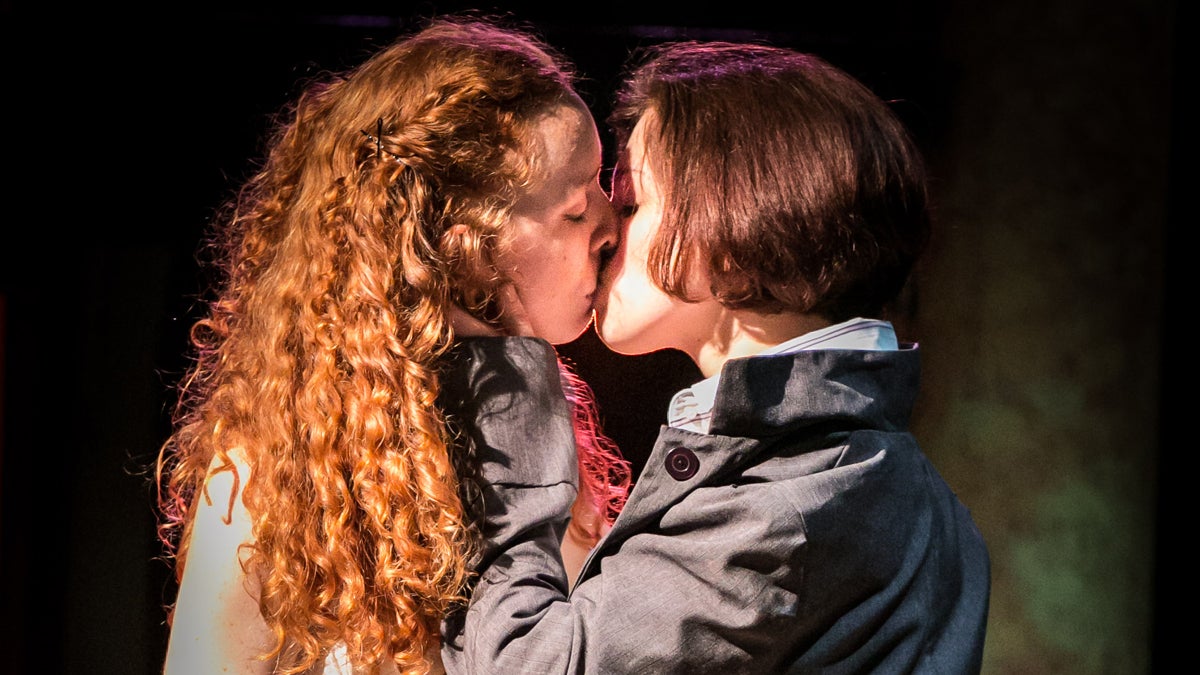Critic’s Notebook: Gender-swapped Romeo provocative, but is it effective theater?

Isa St. Clair (left) as Juliet and Rachel Gluck as Romeo in Curio Theatre Company’s "Romeo and Juliet." (Photo courtesy of Rebecca Miglionico)
Reports that the small and feisty Curio Theatre Company in West Philadelphia has been getting hate mail — even a death threat — aimed at a current production of “Romeo and Juliet” suggest that people are taking their theater a little too seriously. Or, more likely that the fringe of crazies is at it again.
Peter Crimmins, WHYY’s arts and culture reporter, tells the story on this site in a current posting. In a nutshell, Curio decided to do a lesbian version of “Romeo and Juliet,” thereby ruffling the feathers of some people — not people in the audience, maybe not people who ever go to the theater, but some people who comment on blogs. They came out to play, many of them with hatred as their toys, after Philadelphia Magazine blogger Victor Fiorillo wrote a perfectly sober piece announcing Curio’s plan. That article was picked up by the high-profile Drudge Report, and that’s when the underside of the First Amendment — the part that allows the haters to take the floor — became obvious.
The people who run Curio, which performs as a tenant in a West Philly church that houses Methodist, Mennonite and Jewish congregations and is also a general community center, did the right thing: They took it seriously, especially since threats included some aimed directly at them and not on the website. They beefed up security at least for the first part of the run, which ends Nov. 2. There’ve been no incidents.
But the question arises: Why stage a lesbian “Romeo and Juliet” in the first place? If you’re an audience member, you may well ask that. If you’re a theater artist, you’ll probably answer: “Why not?”
An impish artistic impulse
A prevailing question for any artist is: “What if?” What if I paint an entire ceiling in this church?, an artist in Italy once asked. What if I make this lady smile enigmatically so that we’ll never know what she’s thinking?, asked another. What if I bring two lovers from feuding families together in a super-sweet romance, then turn the whole thing into a tragedy about hatred?, asked a playwright. And so on. The only surprise about the lesbian “R&J” at Curio is that not a lot of people asked “What if?” until now.
Gender-bent theater is as old as ancient Greece and a new as the last decade or so. I can’t imagine Euripides’ “Medea” being performed by a guy — I don’t have an artist’s “What if?” — but doubtless, it was. And so were all the women’s roles in Shakespeare’s time, as by law.
There’s still a lot of that going on, and sometimes it could be great fun — tickets are going fast for the all-male version of Shakespeare’s “Twelfth Night” that will open in a few weeks on Broadway, with the celebrated actor Mark Rylance in the role of love-struck Olivia. In one instance last year, Actors’ Equity, the union, stepped into the gender-swapping discussion to argue that what’s good for geese is good for ganders, in a complaint against a theater company that blocks women from performing in all-male productions in London.
But these days, when we talk about swapping genders in the theater, we often mean something very different from men simply playing the roles of women. We mean men turning women’s characters into male characters, and women turning male characters into females. That’s the sort of thing that gives some theatergoers pause — not enough to threaten death, mind you, but maybe enough to form a mindset against a production before even seeing it.
Sometimes it works; sometimes not
In the case of Curio’s “Romeo and Juliet,” that would be silly. I saw the production, directed smoothly by Krista Apple-Hodge, last night. It has an especially fine Juliet in Isa St. Clair, who delivers some of Shakespeare’s most beautiful language as if it were written for today, and a sort-of butch Romeo that I couldn’t quite buy into in Rachel Gluck’s interpretation, also well-spoken. It also has Colleen Hughes as a punky, knife-happy Tybalt, the (usually male) cousin of Juliet who’s dying for a fight.
None of this is the sort of thing that calls for action, although it does call for consistency — and that’s where a lot of the experiments with gender bending get tough. When the two women are married in the church by Friar Lawrence, it made me wonder why he wasn’t played by a woman and as a woman — now that would have been radical. And then we have the problem of gender references in the text. Apple-Hodge, in overseeing the script as part of her director’s role (and indeed, editing it down, as all Shakespeare directors must do to make it work nowadays), was careful to have characters directly refer to both Romeo and Juliet as women and as “she,” but we still get strays: dialogue about “honesty in men” and the word “sir.”
That might seem like a picky criticism, but it’s not; because we’re watching a sex-changed production of an iconic play, such little references take on a lot of weight, and bang us over our heads. I didn’t glean new insight because of the gender swaps in Curio’s production. But even in productions that give a play a whole new reading — e.g., Mauckingbird Theatre Company’s mostly male (and intentionally gender-changed) “The Importance of Being Earnest” in Center City this summer — directors are unwilling to take the ultimate step by changing characters’ names.
Adding new layers
Not only were the two male characters, Algernon and Jack, still guys, so were their love interests — males still named Gwendolyn and Cecily. Because of that, the production operated in two different intellectual time zones — in one, we were accepting that these are gay couplings. In the other, whenever we heard their names, we knew that this was an artificial idea, imposed on the play.
That particular production said a lot about same-sex marriage and the debate today, infusing Oscar Wilde’s play with a prescience he could not have imagined. I didn’t get that from Curio’s “R&J,” perhaps because not enough characters got the gender change to make any statement at all.
Gender changing, particularly with Shakespeare’s work, has become serious business. An association of Shakespearean actors and directors from around world met in January at the Pennsylvania Shakespeare Festival offices at DeSales University, near Quakertown, and one of their most anticipated sessions had them trying to imagine how the opposite sex would feel in a gender-changed character written by the Bard. For each participant, it was serious and highly personal training.
And by all accounts, such swaps are becoming more acceptable to audiences — if they shed new light on an old script. I don’t think it made any difference in another production this summer, again in West Philadelphia. There, Shakespeare in Clark Park chose “The Tempest” as its annual show, and changed the gender of several roles. I couldn’t see why, certainly not for any impact on the script. Then a well-respected local director told me that “there are just not many roles for women in Shakespeare. And,” he said, “with the pool of talented men and women now acting in Philadelphia, shouldn’t women have a chance?”
Put it that way, I understand it completely — but as a fair-employment decision and not an artistic one. Two years ago, local theater artist Mary Tuomanen played Hamlet in a Philadelphia Shakespeare Theatre production. I didn’t agree with her impetuous interpretation, but she clearly had the chops to perform the role, so why not? Then again, she was playing Hamlet as a guy, not as the Princess of Denmark. Yikes, it’s all so tricky. “Act like a man,” a director once might have advised to a rehearsing performer whose interpretation needed a change. Now, it’s sometimes more like: “Act as a man! Or — wait a minute … as a woman playing a man … or no, that’s not it. Just act like a person.”
WHYY is your source for fact-based, in-depth journalism and information. As a nonprofit organization, we rely on financial support from readers like you. Please give today.




